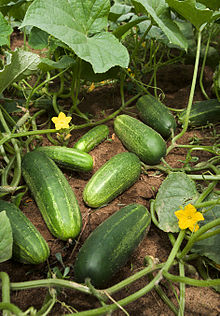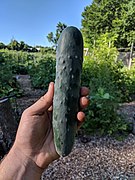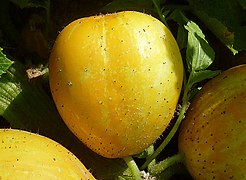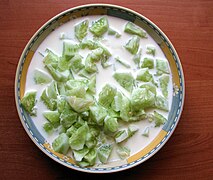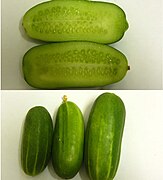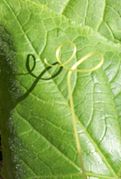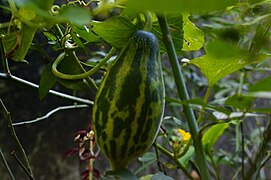
A grape is a fruit, botanically a berry, of the deciduous woody vines of the flowering plant genus Vitis. Grapes are a non-climacteric type of fruit, generally occurring in clusters.

A mango is an edible stone fruit produced by the tropical tree Mangifera indica. It originated from the region between northwestern Myanmar, Bangladesh, and northeastern India. M. indica has been cultivated in South and Southeast Asia since ancient times resulting in two types of modern mango cultivars: the "Indian type" and the "Southeast Asian type". Other species in the genus Mangifera also produce edible fruits that are also called "mangoes", the majority of which are found in the Malesian ecoregion.

Cucurbita is a genus of herbaceous fruits in the gourd family, Cucurbitaceae, native to the Andes and Mesoamerica. Five edible species are grown and consumed for their flesh and seeds. They are variously known as squash, pumpkin, or gourd, depending on species, variety, and local parlance. Other kinds of gourd, also called bottle-gourds, are native to Africa and belong to the genus Lagenaria, which is in the same family and subfamily as Cucurbita, but in a different tribe. These other gourds are used as utensils or vessels, and their young fruits are eaten much like those of the Cucurbita species.

The radish is an edible root vegetable of the mustard family, Brassicaceae, that was domesticated in Asia prior to Roman times.

A melon is any of various plants of the family Cucurbitaceae with sweet, edible, and fleshy fruit. The word "melon" can refer to either the plant or specifically to the fruit. Botanically, a melon is a kind of berry, specifically a "pepo". The word melon derives from Latin melopepo, which is the latinization of the Greek μηλοπέπων (mēlopepōn), meaning "melon", itself a compound of μῆλον (mēlon), "apple", treefruit " and πέπων (pepōn), amongst others "a kind of gourd or melon". Many different cultivars have been produced, particularly of cantaloupes.

In botany and horticulture, parthenocarpy is the natural or artificially induced production of fruit without fertilisation of ovules, which makes the fruit seedless. The phenomenon has been observed since ancient times but was first scientifically described by German botanist Fritz Noll in 1902.

Momordica charantia is a tropical and subtropical vine of the family Cucurbitaceae, widely grown in Asia, Africa, and the Caribbean for its edible fruit. Its many varieties differ substantially in the shape and bitterness of the fruit.

The zucchini, courgette or baby marrow is a summer squash, a vining herbaceous plant whose fruit are harvested when their immature seeds and epicarp (rind) are still soft and edible. It is closely related, but not identical, to the marrow; its fruit may be called marrow when mature.
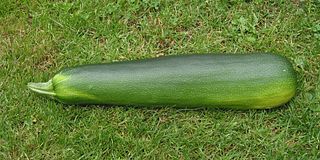
A marrow is the mature fruit of certain Cucurbita pepo cultivars used as a vegetable. The immature fruit of the same or similar cultivars is called courgette or zucchini. Like courgettes, marrows are oblong, green squash, but marrows have a firm rind and a neutral flavour, making them useful as edible casings for mincemeat and other stuffings. They can be stored for several weeks after harvest, to be processed for food when required. They are a vegetable used in Great Britain and areas with significant British influence, though their popularity is waning in favor of immature summer squash like courgette.

Cucumis is a genus of twining, tendril-bearing plants in the family Cucurbitaceae which includes the cucumber, true melons, the horned melon, and the West Indian gherkin.

Cucumis anguria, commonly known as maroon cucumber, West Indian gherkin, maxixe, burr gherkin,cackrey, and West Indian gourd, is a vine that is indigenous to Africa, but has become naturalized in the New World, and is cultivated in many places. It is similar and related to the common cucumber (C. sativus) and its cultivars are known as gherkins.

The Armenian cucumber, Cucumis melo Flexuosus Group or Cucumis melo var. flexuosus, is a type of long, slender fruit which tastes like a cucumber and looks somewhat like a cucumber inside. It is actually a variety of true melon, a species closely related to the cucumber. It is also known as the yard-long cucumber, snake cucumber, snake melon, chanbar in Persian, tirozî in Kurdish, sheng in Semnani, uri in Japanese, acur in Turkish, kakadee in Hindi, tar in Punjabi, قثاء in Arabic, commarella or tortarello in Italian. It should not be confused with the snake gourds. The skin is very thin, light green, and bumpless. It has no bitterness and the fruit is almost always used without peeling. It is also sometimes called a gutah.

Cucurbita moschata is a species originating in either Central America or northern South America. It includes cultivars known as squash or pumpkin. C. moschata cultivars are generally more tolerant of hot, humid weather than cultivars of C. maxima or C. pepo. They also generally display a greater resistance to disease and insects, especially to the squash vine borer. Commercially made pumpkin pie mix is most often made from varieties of C. moschata. The ancestral species of the genus Cucurbita were present in the Americas before the arrival of humans. No species within the genus is fully genetically isolated from all the other species. C. moschata can be hybridized with all other species. It has been suggested that this shows that the species of Cucurbita have diversified more recently than those of related genera such as Cucumis and Citrullus.

The tomato is the edible berry of the plant Solanum lycopersicum, commonly known as the tomato plant. The species originated in western South America, Mexico, and Central America. The Nahuatl word tomatl gave rise to the Spanish word tomate, from which the English word tomato derives. Its domestication and use as a cultivated food may have originated with the indigenous peoples of Mexico. The Aztecs used tomatoes in their cooking at the time of the Spanish conquest of the Aztec Empire, and after the Spanish encountered the tomato for the first time after their contact with the Aztecs, they brought the plant to Europe, in a widespread transfer of plants known as the Columbian exchange. From there, the tomato was introduced to other parts of the European-colonized world during the 16th century.

Melothria scabra, commonly known as the cucamelon, Mexican miniature watermelon, Mexican sour cucumber, Mexican sour gherkin, mouse melon, or pepquinos, is a species of flowering plant in the cucurbit family grown for its edible fruit. Its native range spans Mexico to Venezuela. Cucumis melo Agrestis and Cucumis callosus is cultivated as Chibber Fruit or Kachri in South Asia and can also grow as weed. Fruits are about the size of grapes and taste like cucumbers with a tinge of sourness. It may have been eaten by indigenous peoples before the European colonization of the Americas began.
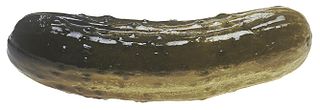
A pickled cucumber – commonly known as a pickle in the United States and Canada and traditionally a gherkin in Britain, Ireland, South Africa, Australia, and New Zealand – is a usually small or miniature cucumber that has been pickled in a brine, vinegar, or other solution and left to ferment. The fermentation process is executed either by immersing the cucumbers in an acidic solution or through souring by lacto-fermentation. Pickled cucumbers are often part of mixed pickles.

Watermelon is a flowering plant species of the Cucurbitaceae family and the name of its edible fruit. A scrambling and trailing vine-like plant, it is a highly cultivated fruit worldwide, with more than 1,000 varieties.
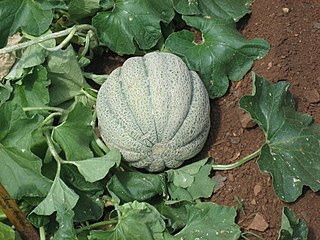
Cucumis melo, also known as melon, is a species of Cucumis that has been developed into many cultivated varieties. The fruit is a pepo. The flesh is either sweet or bland, with or without a musky aroma, and the rind can be smooth, ribbed, wrinkled, or netted. In North America, the sweet-flesh varieties are often collectively called muskmelon, including the musky netted-rind varieties and the inodorous smooth-rind varieties, and cantaloupe usually refers to the former type. However, muskmelon in a narrow sense only refers to the musky netted-rind type, also known as North American cantaloupe, while the true cantaloupe is the European type with ribbed and often warty rind that is seldom grown in North America.
